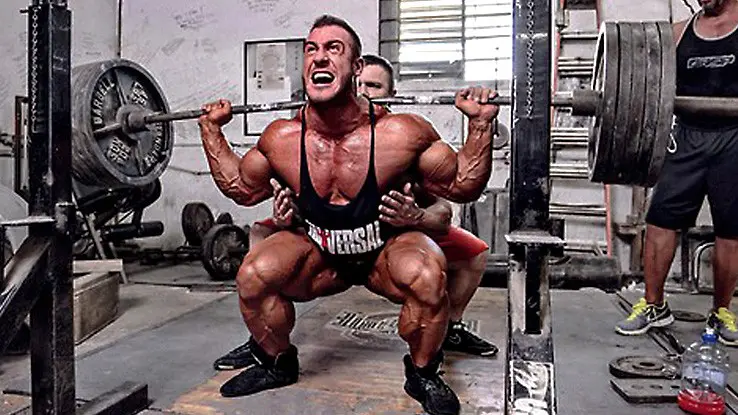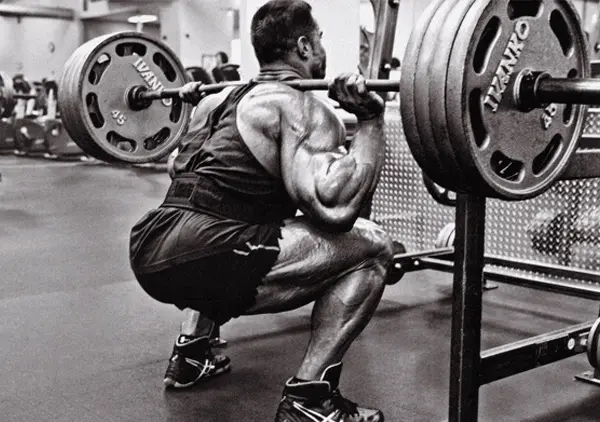Squats are one of the best exercises you can do. Whatever your training goal is, a regular dose of squats will help you get there sooner. Bodyweight squats are a great toning and conditioning exercise, while barbell squats are one of the best ways to build quadriceps, glutes, and hamstring muscle mass.
Athletes from almost every sport use squats to boost running and jumping performance. They are also the best exercise for testing and developing leg strength. That’s why they are the first lift contested in powerlifting competitions.
But how deep should you squat? That’s a question with seemingly only one answer!
According to countless memes and snappy tee-shirt slogans, the only good squat is a deep squat. By deep, we’re talking “ass to grass” which is gym-speak for descending until your hamstrings touch your calves. In other words, as deep as is humanly possible.
But, do you really need to squat this deep? And what if you can’t squat ass to grass; does this mean your squats are worthless? It turns out that not everyone can or should squat to maximal depth, and trying to squat deep when you aren’t built for it could lead to serious injury.
Several factors determine how deep you can and should squat.
Level Up Your Fitness: Join our 💪 strong community in Fitness Volt Newsletter. Get daily inspiration, expert-backed workouts, nutrition tips, the latest in strength sports, and the support you need to reach your goals. Subscribe for free!
1. Height and leg length
In general, tall lifters have a harder time squatting deep then shorter lifters. Long femurs (thigh bones) and torsos increase the distance the weight has to travel and also mean the weight is further from the base of support (your feet). This increases leverage and difficulty.
These problems can be partially mitigated by adopting a wider than normal squat stance. This should allow tall lifters to squat more deeply. But, on the downside, a wide squat stance takes stress off your quadriceps and increases the load on the adductors or inner thighs.
2. Hip mobility
Tight hip muscles can prevent you from squatting deeply. Tight hamstrings, the muscles on the back of your thigh, cross both your knee and your hip joints. If they are tight, as you descend, they will physically stop you from flexing (bending) your hip as much as you want (1). If you try to squat any deeper, you may even see some “butt wink,” which is where the pelvis tucks under, and the lower back becomes rounded.
Poor hip mobility and butt wink can lead to injury if you try and squat too deep – especially with heavyweights. Any rounding of lower puts more stress on your intervertebral discs and spinal ligaments. If injured, these structures take a long time to heal and, in the case of disc injuries, may not heal at all and could require surgery to repair.
3. Ankle mobility
Tight, immobile ankles can have a profound effect on your squat depth. If your calves are tight, your heels will lift off the floor as you squat past parallel. This will make you unstable, reduce the amount of weight you can lift, and also stop you from squatting as deeply (1).
Some lifters wear weightlifting shoes with raised heels to get around this problem, while others squat with their heels on weight plates or blocks of wood. While these strategies will allow you to squat a little deeper, they do so by treating the symptom and not the cause of your reduced ankle mobility. If tight calves are preventing you from squatting deeply, the best solution is stretching.
4. Type of squat
If you want to squat deeper, some variations are better than others. Barbell front squats and kettlebell goblet squats are best for smooth, deep squats. High bar squats, where the bar rests high on the upper traps, come a close second. All of these types of squat allow you to keep your body more upright, which usually leads to a deeper squat.
Low bar back squats, where the bar is held low on the shoulders, is the worst type of squat for going really deep. Low bar squats encourage a lot of forward lean. That’s great for lifting hefty weights, but not so good for squat depth. Low bar squats are popular in powerlifting.
5. Knee health
The knee joint is a synovial hinge joint, which means it is made up of two bones, the ends of which are covered in smooth, tough, hyaline cartilage and lubricated with synovial fluid. This joint opens and closes like a hinge, hence its name.
Level Up Your Fitness: Join our 💪 strong community in Fitness Volt Newsletter. Get daily inspiration, expert-backed workouts, nutrition tips, the latest in strength sports, and the support you need to reach your goals. Subscribe for free!
Synovial joints are prone to wear and tear. That wear and tear can lead to the formation of rough surfaces within the joint, which can affect the range of motion and mobility. If you have been training a long time, or are a little on the older side, your knee joints may not be up to deep squatting. In addition, a history of knee injuries may mean that deep squats are no longer possible or advisable.
6.Using too much weight
A lot of exercisers squat less deeply when they lift heavyweights. After all, if you don’t squat as deep, the weight doesn’t have to travel as far and that makes for a more manageable rep. In most cases, this is a form of cheating, and you’ll get better results from deeper squats with a smaller load.
You don’t do half-rep bench presses or biceps curls, so don’t do half-depth squats either. The only exception to this rule is if you are training for increased vertical jump performance. Studies suggest that half-depth squats are a very effective way to boost jump height (2).
7. Your reason for squatting
Your ideal squat depth is not just based on your anatomy and physiology, but also your specific training goals. Powerlifters only need to squat down until their thighs are parallel to the floor. Squatting deeper is just a waste of energy and could reduce the amount of weight lifted.
In contrast, Olympic lifters need to drop into a very deep squat during the clean and the snatch. This allows them to really “get under” the bar so they can lift heavier weights.
Bodybuilders and general exercisers work out for the results they get from their training, rather than trying to see how much weight they can lift. Squat depth is much less important, and, up to a point, shallow heavy squats can be as productive as deep light squats as both expose your target muscles to a form of stimulation. However, as the range of motion is important for muscle growth, most exercisers should generally avoid very shallow squats.
So, how deep should you squat?
If you are a powerlifter, you must squat to the correct depth, i.e., thighs parallel to the floor, for your lift to count. Some federations are stricter than others, but you should make sure you train to hit the same depth you’ll need to reach in competition. If you can’t hit the right depth, you need to work on your hip and ankle mobility.
Bodybuilders and general exercisers should squat as deep as they can without triggering butt wink. Watch your pelvis in the mirror as you squat and stop your rep just before your butt tucks under. Try to hit the same depth for each and every rep you perform.
While there is no need to force yourself to squat deeper than comfortable, you shouldn’t cut your depth short either. Regardless of leg length, hip and ankle mobility, and type of squat being performed, most lifters should be able to achieve the same depth as a powerlifter, i.e., thighs close to parallel to the floor. If you cannot achieve this depth, you may need to work on your flexibility or squat with less weight.
Conclusion
Now you know which factors affect squat depth, you should understand why some people can squat deeper than others, and why some people may never achieve a full, ass to grass squat. Some factors, such as height, leg length, and knee health, are unmodifiable. Other factors, such as hip and ankle mobility, can be improved to increase squat depth.
Remember, though, there is no requirement to squat hamstrings to calves if you can’t or don’t want to. Instead, squat to the depth that gives you the results you want with the lowest risk of injury. Don’t cut your reps short, but don’t squat so deep you experience the dreaded butt wink either. Back injuries from butt wink could prevent you from squatting at all.
References:
1– Kim, Si-Hyun; Kwon, Oh-Yun; Park, Kyue-Nam; Jeon, In-Cheol; Weon, Jong-Hyuck (April 7, 2015). “Lower Extremity Strength and the Range of Motion in Relation to Squat Depth”. Journal of Human Kinetics. 45: 59–69. doi:10.1515/hukin-2015-0007. ISSN 1640-5544. PMC 4415844. PMID 25964810. https://www.ncbi.nlm.nih.gov/pmc/articles/PMC4415844/
2– Boullosa, Daniel A.; Abreu, Laurinda; Beltrame, Luis G. N.; Behm, David G. (2013-08). “The acute effect of different half squat set configurations on jump potentiation”. Journal of Strength and Conditioning Research. 27 (8): 2059–2066. doi:10.1519/JSC.0b013e31827ddf15. ISSN 1533-4287. PMID 23207892. https://www.ncbi.nlm.nih.gov/pubmed/23207892











